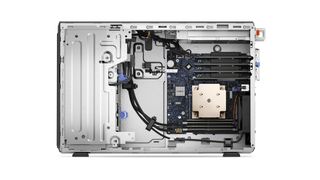IT Pro Verdict
Pros
- +
Outstanding value
- +
Strong performance
- +
Highly upgradeable
- +
Fantastic remote management capabilities
Cons
- -
No SFF drive cage option
When designing the new PowerEdge T350 tower server, Dell EMC originally considered using the same chassis as the mighty T550. But SMBs said no – they wanted something much more space-efficient. And so it came to pass: the T350 introduces a brand-new mini-tower format that’s 37% smaller than its predecessor, the T340.
The size reduction doesn’t come at the cost of power. This single-socket server supports Intel’s Xeon E-2300 CPUs and up to 128GB of DDR4 memory, while eight internal LFF hot-swap drive bays offer plenty of storage potential. There isn’t an SFF drive cage option, but smaller SFF hard disks and SSDs can also be mounted in hybrid drive carriers.
While the PowerEdge T350 is a more lightweight server than the T550, it shares the exceptional build quality of its big brother. The chassis is constructed of sturdy pressed steel panels all round, with a weighty metal removable side, and sports Dell EMC’s trademark honeycomb front cover.
Pricing starts at a terrifically affordable £1,273: that gets you a quad-core 2.8GHz Xeon E-2314 CPU and 16GB of memory. There are plenty of other options, though, as the T350 supports all ten Xeon E-2300 CPUs. For our review we chose a faster 3.1GHz Xeon E-2324G and a variety of upgrades which we’ll discuss below, bringing the price to a still very reasonable £2,382.
The smaller chassis means there’s less working space inside than on the old T340, but with the side panel removed you’ll find everything neatly arranged and easy to access. Cooling is handled by a quiet 9cm fan at the rear, and the motherboard is covered by a solid plastic shroud to assist air flow. The CPU is fitted with a large passive heatsink, beneath which sit four DDR4 DIMM slots. We chose to install a single 32GB 3,200MHz module in one of these, leaving three available for future upgrades. Base systems are powered by a fixed 450W Bronze PSU, but beefier configurations such as ours can use dual hot-swap 600W Platinum PSUs.

Storage RAID options are plentiful. The motherboard comes with a basic S150 SATA controller, but you can choose from an extensive range of PERC adapter cards. Our system includes the entry-level PERC H345 SAS3/SATA card, which offers hardware-managed RAID0, 1 and 10 arrays; pricier 700-series adapters add RAID5 and 6, plus battery-protected cache memory. With the RAID card in place you’re still left with three spare PCI-E slots to play with, so you can also add a 10GbE card if the the T350’s dual Gigabit Ethernet ports don’t suffice for your needs.
One valuable feature passed down from the T550 is support for Dell EMC’s boot-optimised storage solution (BOSS) S2 card. This runs the operating system from a mirrored pair of M.2 SATA SSDs, allowing for maximum speed and resilience while freeing up the main drives for data storage. The SSDs are presented at the front in hot-swap carriers, and our server setup included the card and dual 240GB drives.
You also get the same excellent remote management features as on much bigger servers. Dell EMC’s embedded iDRAC9 controller provides tons of valuable information on server operations and hardware status through a slick web console. You can also monitor the server from a mobile device; we used the OpenManage iOS app on an iPad to view the server’s status, pull up a list of hardware and receive alerts on health issues. We went for an iDRAC9 Enterprise licence, which enables full OS remote control and virtual media services. We used the latter to attach a remote Windows Server 2022 ISO to the server and had the OS installed on the BOSS card in under 30 minutes.
The PowerEdge T350 is a fantastic little machine for SMBs and branch offices seeking a capable but affordable single-socket tower server. With support for a whole spread of Xeon E-2300 CPUs and a big helping of memory it can be specified to meet a wide range of needs, while the high storage capacity and plenty of expansion space provide room to grow.
Dell EMC PowerEdge T350 specifications
| Chassis | Tower chassis |
| CPU | 3.1GHz Intel Xeon E-2324G |
| Memory | 32GB 3,200MHz DDR4 ECC (max 128GB) |
| Storage bays | 8 x LFF/SFF hot-swap drive bays, supports 2 x 2TB SATA hard disks |
| Storage included | BOSS S2 with 2 x 240GB SATA M.2 SSDs |
| PSU | 2 x 600W hot-plug PSUs |
| RAID support | RAID0, 1, 10 |
| Network | 2 x GbE |
| Other ports | Dell PERC H345 SAS/SATA PCI-E card, 2 x PCI-E 4, 2 x PCI-E 3 |
| Management | iDRAC9 Enterprise with GbE |
| Dimensions (WDH) | 175 x 595 x 382mm |
| Warranty | 3yr basic on-site NBD warranty |
Dave is an IT consultant and freelance journalist specialising in hands-on reviews of computer networking products covering all market sectors from small businesses to enterprises. Founder of Binary Testing Ltd – the UK’s premier independent network testing laboratory - Dave has over 45 years of experience in the IT industry.
Dave has produced many thousands of in-depth business networking product reviews from his lab which have been reproduced globally. Writing for ITPro and its sister title, PC Pro, he covers all areas of business IT infrastructure, including servers, storage, network security, data protection, cloud, infrastructure and services.



